Peridot, with its radiant green glow, is unique in its own way. Knowing how to identify peridot can be an exciting journey. Scattered across various parts of the world, you can find this gem in both volcanic and mountainous regions.
If you’re ever on a gem-hunting adventure, regions with volcanic activity or deserts are the best places to start looking for peridot. Hunting for it is a thrilling experience, especially when equipped with the right knowledge.
From its distinct color to its translucency, there’s much to learn and appreciate about this gem. Dive in to uncover the world of peridot and the clues that reveal its identity.
What peridot is
Peridot is a stunning green gemstone and is a variety of the mineral olivine. How peridot is formed is quite intriguing. Deep beneath the Earth’s crust, in the upper mantle, this gem is birthed from molten rock.
As the Earth’s tectonic plates move and volcanoes erupt, peridot is brought closer to the surface. Once on the surface, it’s often found in places where volcanic activity has been prevalent.
In the United States, regions like Arizona and New Mexico are well-known for their peridot deposits. This gem’s unique formation process and its mesmerizing color make it a favorite for collectors and jewelry enthusiasts alike.
The different types of peridot
Diving into the world of peridot is like exploring different shades of green in a forest. Not all peridot gems are the same; they come in various types, each with its own unique charm.
Arizona Peridot
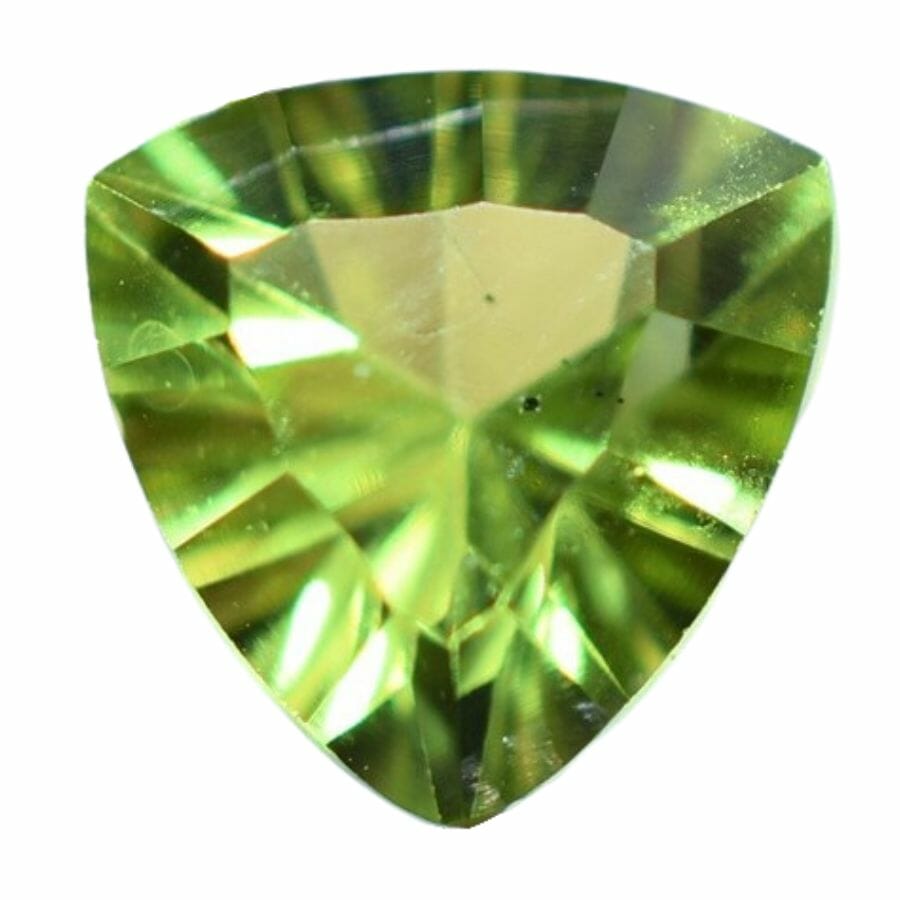
Arizona peridot comes mainly from the San Carlos Apache Reservation in Arizona. It’s known for its bright and rich green hue, often brighter than peridots from other regions.
The Arizona desert landscape, with its unique climate and geology, gives this peridot its vivid color.
Many gem enthusiasts and jewelers prefer Arizona peridot because of its pure green shade with minimal brown or yellow undertones. So, when you see a dazzling, vibrant green peridot, there’s a good chance it’s an Arizona treasure!
Pakistani Peridot
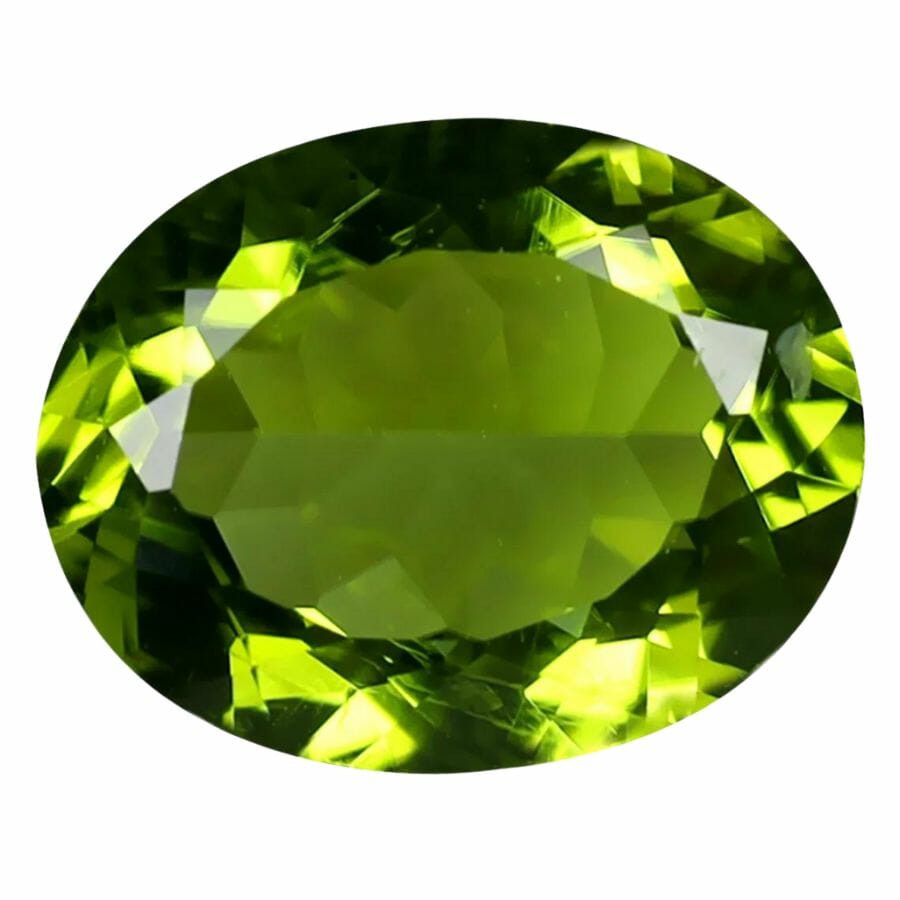
Hailing from the mountainous regions of Pakistan, Pakistani peridot is known for its rich, deep green color. Many consider it among the finest in the world because of its captivating shade and superb clarity.
The mines in Pakistan’s northwest are the prime source of these vibrant gems. Due to the high altitude and remote location, mining for this gem can be challenging. But the result is absolutely worth it.
Burmese Peridot
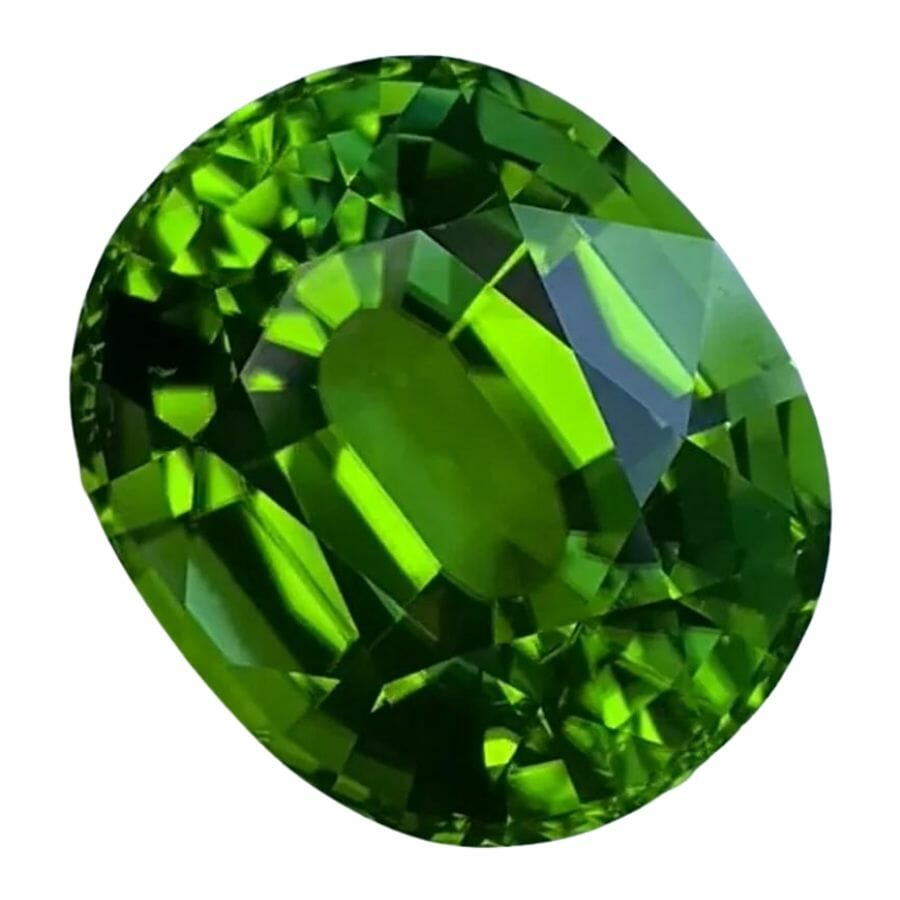
Burmese peridot stands out with its radiant green shade and top-notch clarity. Mined in Myanmar, formerly known as Burma, these gems often showcase a vibrant, rich color that can be brighter than peridots from other locations.
Thanks to its mesmerizing hue and high transparency, Burmese peridot is extremely popular among jewelry makers and gem collectors.
Where to find peridot
Exploring the United States can lead to some sparkling discoveries, especially for peridot enthusiasts! From vast deserts to volcanic terrains, certain places offer a better chance to uncover this gemstone’s beauty.
Peridot Mesa, Arizona
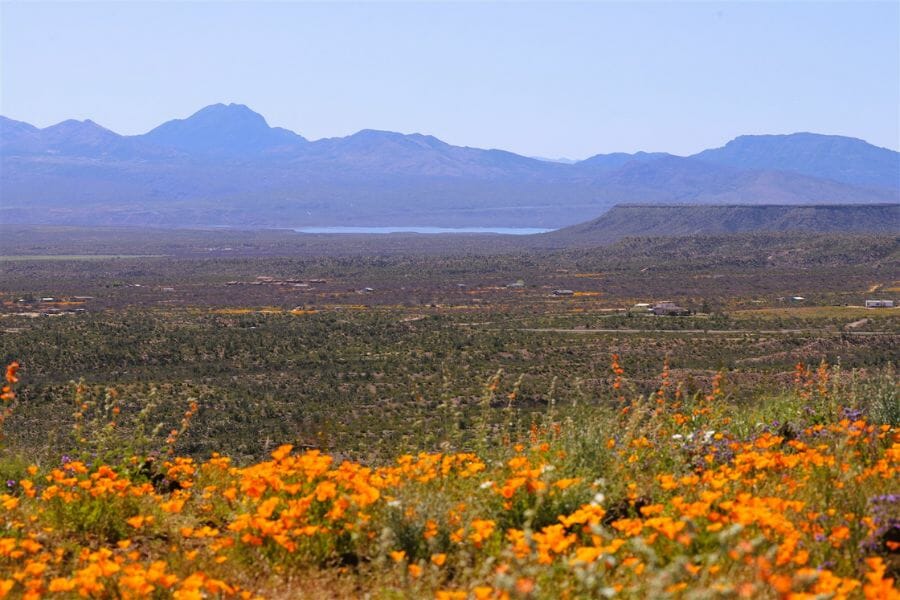
Located within the vast landscapes of the San Carlos Apache Reservation, Peridot Mesa stands out as one of the prime spots where you can find peridot in the United States.
The area is rich with bright green gems, making it a favorite destination for both novice and experienced collectors. The peridot found here is typically vibrant and of high quality, with colors ranging from a lively lime green to a deeper olive shade.
Its clear, almost glassy appearance makes Peridot Mesa’s treasures highly sought after.
Williams, Arizona
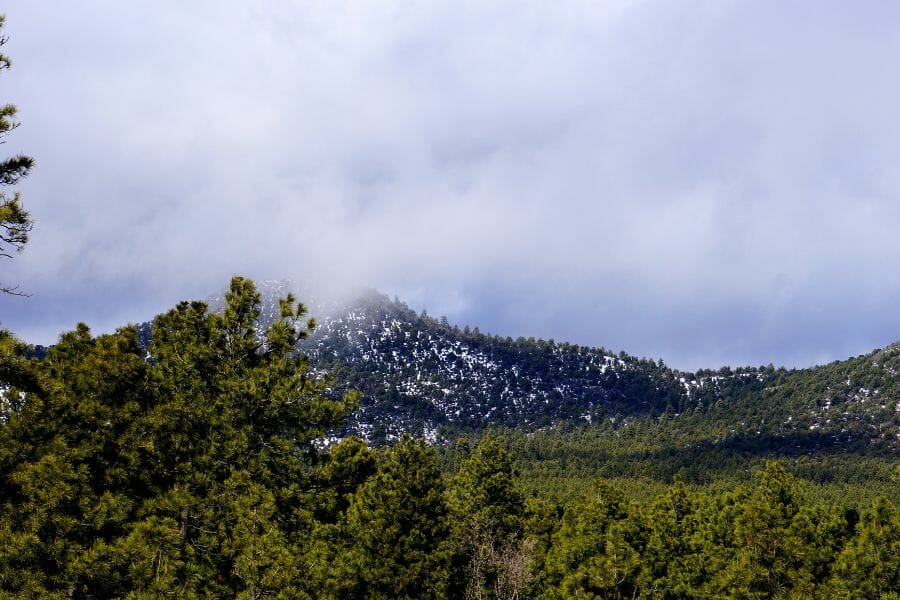
Williams is a charming city known as the “Gateway to the Grand Canyon.” But beyond its scenic beauty and historical landmarks, it’s also a hotspot for gem enthusiasts.
The region around Williams is rich with deposits of peridot, making it an exciting destination for those eager to find this vibrant green gemstone.
The types of peridot you can uncover here vary in shade from a refreshing light green to a more intense olive hue.
Their clarity and sparkle make them a delightful find for anyone exploring the area.
Kilbourne Hole Volcanic Maar, New Mexico
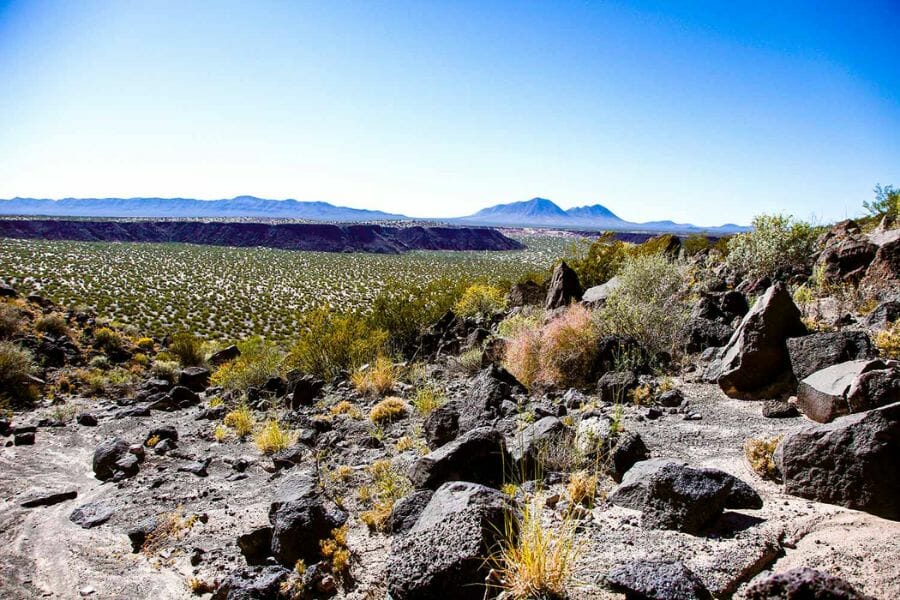
Kilbourne Hole Volcanic Maar is a fascinating spot on the map. It’s not just any crater; it’s a remnant of an explosive volcanic event from ages ago!
While it’s a sight to see on its own, it’s also a place where to find peridot in real life. This location is famous for its green gem deposits, attracting rock hounds and gem enthusiasts alike.
The peridot pieces you can discover here range from tiny, glittering grains to larger gem-quality samples.
Leucite Hills, Wyoming
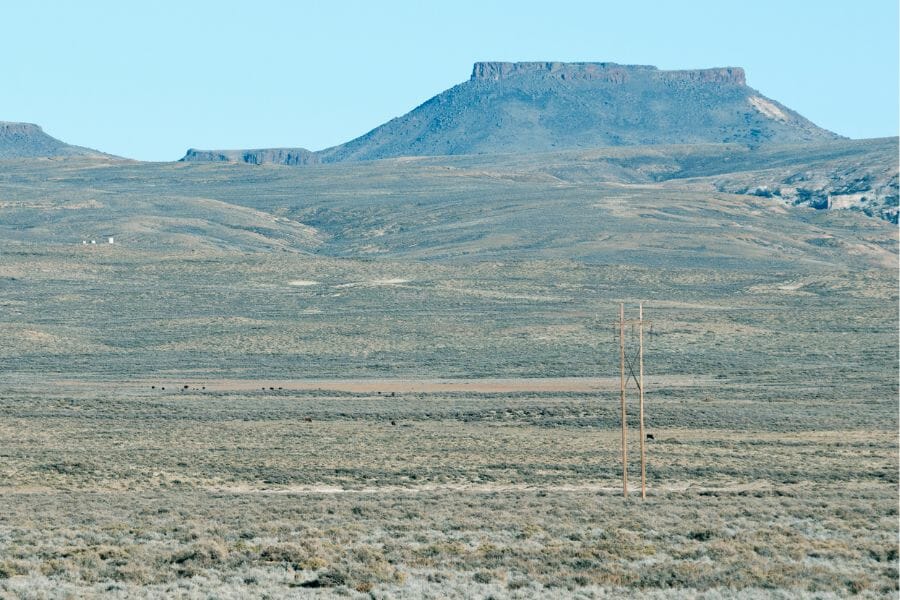
Leucite Hills in Wyoming is a gem hunter’s playground! Set against the backdrop of the expansive Wyoming landscapes, these hills are not just a feast for the eyes but also a treasure trove for rock enthusiasts.
Among the various minerals scattered in this region, peridot claims a special spot. The area is dotted with this vibrant green gem, making it a delightful destination for those keen on adding to their collection.
The peridot found here can vary, with shades ranging from a soft lime green to a deeper, more intense hue.
Papakolea Beach, Hawaii
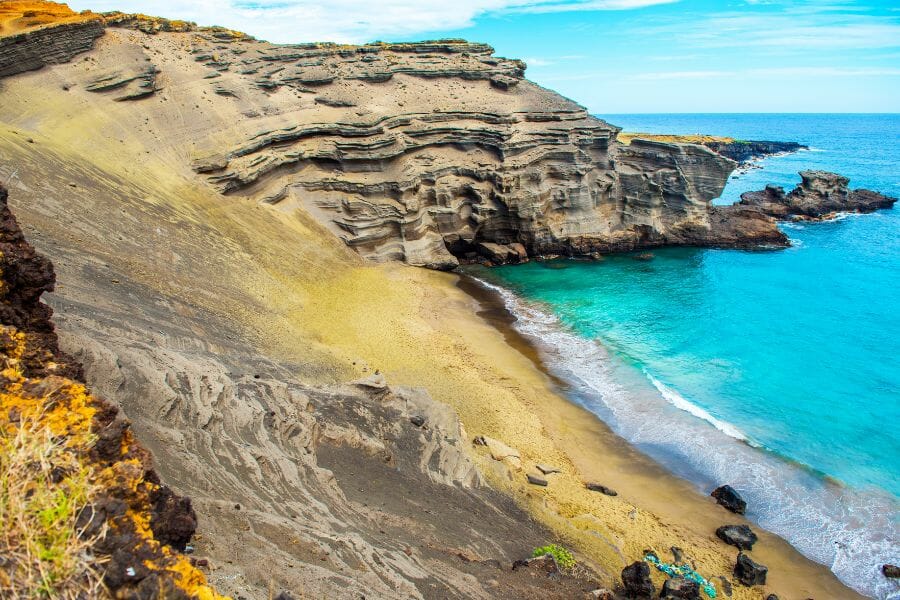
Papakolea Beach is known as one of the few green sand beaches in the world. Its unique color comes from tiny olivine crystals, which are basically peridot’s baby siblings.
While most beaches tempt visitors with golden sands, Papakolea boasts green grains.
These peridot grains here are generally tiny, sparkling brilliantly under the Hawaiian sun. While these might not be the large gem-quality stones, they offer a unique experience, letting you literally walk on a sea of green gems.
How to find peridot
While peridot is a gem loved by jewelers and collectors, it’s also a thrill for those who search for it in nature. These are some of the methods that increase your chances of finding this gem.
Look for specific rocks
Peridot often hangs out in igneous rocks, especially basalt and peridotite. If you spot these rocks, there’s a good chance you might find peridot nearby.
Basalt is a dark-colored rock from cooled lava, and peridotite is a dense, coarse-grained rock loaded with olivine crystals, which is where peridot comes from. When walking in areas rich with these rocks, keep an eye out for green grains or crystals.
Seek out volcanic areas
If you’re on the hunt for peridot, volcanic areas are the places to be! Peridot loves to form deep in the Earth, and when volcanoes erupt, they can bring these green gems closer to the surface.
These areas, where lava has cooled, can be rich with dark rocks like basalt, which might hold tiny peridot crystals.
When exploring, search for regions with a history of volcanic activity. Look for spots where lava rocks are plentiful and start your search there.
Look for greenish pebbles
When learning how to find peridot, a simple trick is to scan the ground for greenish pebbles. In areas known for peridot, these green hints can be the ticket to finding the gem you’ve been looking for.
Now, it’s important to remember that not every green stone is peridot. But spotting them is a great sign that you’re searching in a promising place. Take a closer look at these green gems. Even if they aren’t all gem-quality, finding them can be thrilling.
Bring proper tools
A rock hammer is great for breaking open rocks that might hide these green gems inside. When you think you’ve found a piece, a hand lens or magnifying glass can help you get a closer look and confirm your find.
A small shovel is perfect for digging into areas where peridot might be just beneath the surface.
And if you’re exploring desert regions, consider bringing a sieve. It helps in separating tiny peridot grains from the surrounding sand, making your hunt more efficient.
How to identify peridot once you find it
Finding a gemstone is just the first step of the adventure. Next comes the equally exciting challenge of confirming it’s truly peridot. There are specific characteristics that can help in this identification process.
What peridot looks like on the outside
When searching for gems, knowing their appearance is crucial. Peridot has some unique external features that make it stand out. Let’s explore these characteristics to help identify this gem with confidence.
Color
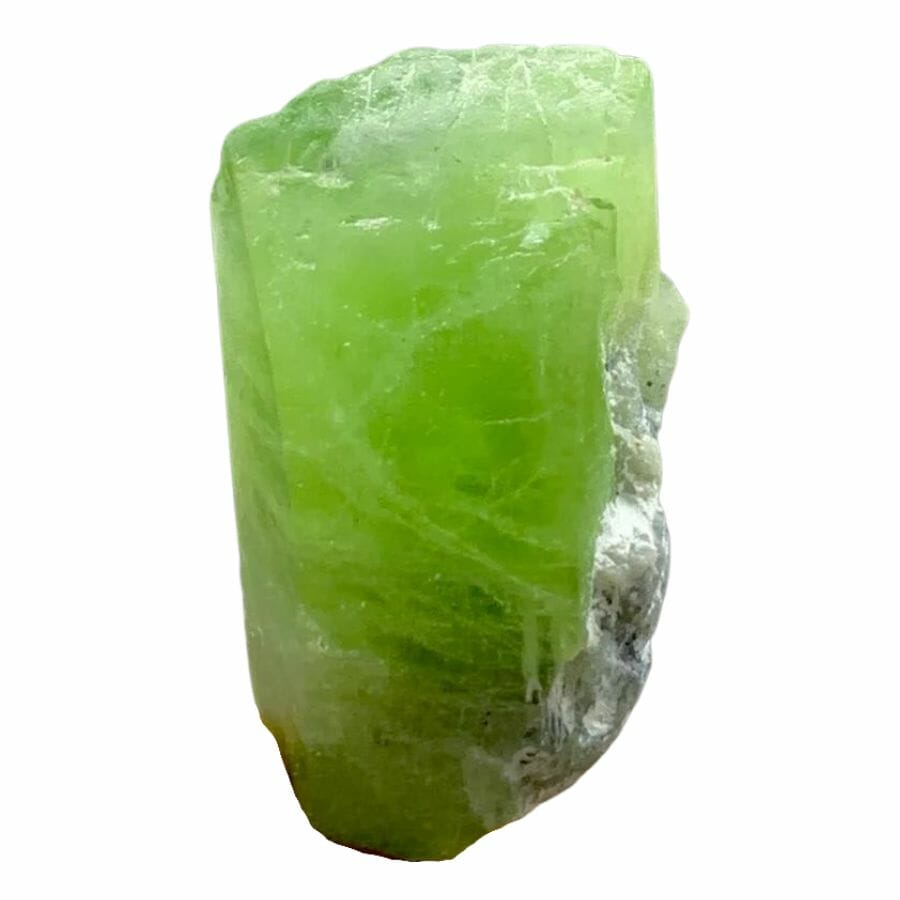
The most defining characteristic of peridot is its captivating color. This gemstone has a beautiful green hue that can vary quite a bit. On one end, you might find pieces that have a yellowish-green tint, almost like fresh sprouts in spring.
Move a bit further on the spectrum, and the shades can shift to a deeper olive green, reminiscent of tree canopies. Some peridots even lean towards a brownish-green, adding a rich warmth to their appearance.
Keeping an eye out for stones in these hues can make peridot hunting easier.
The intensity and exact shade of the green is influenced by the iron content in the stone.
Vitreous Luster
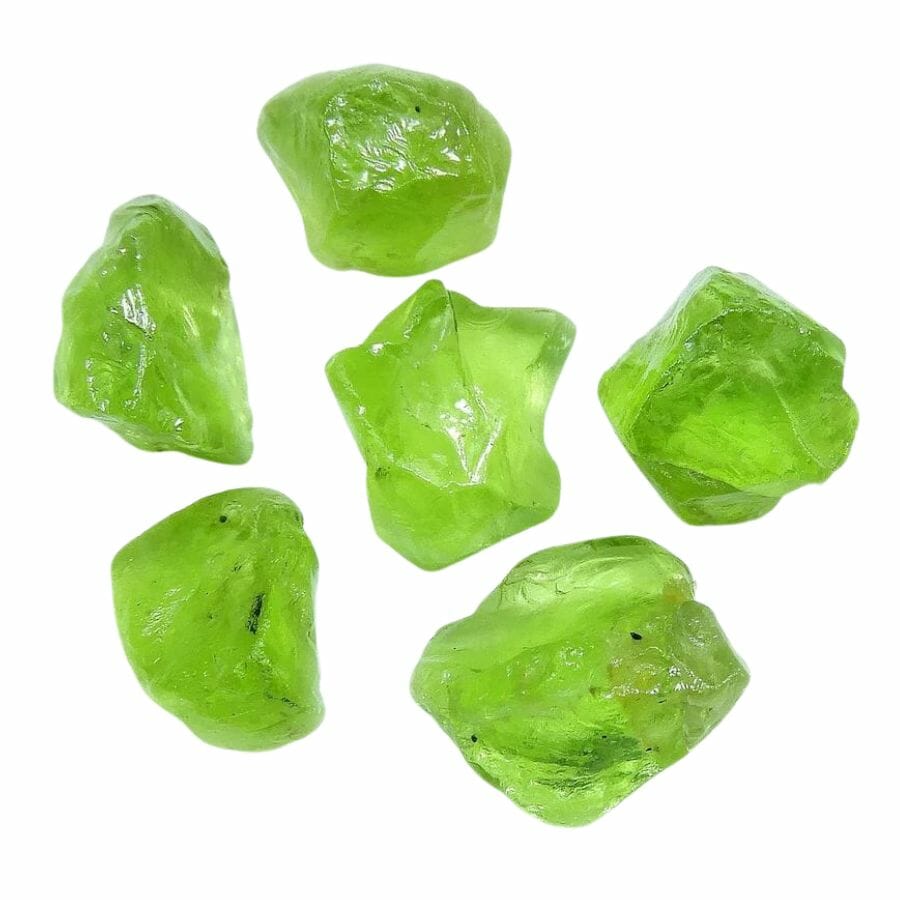
One of the standout features when observing what peridot looks like on the outside is its luster. Luster describes how a mineral reflects light, and peridot has a unique way of shining.
Just think of holding up a piece of polished glass to the sunlight and seeing it gleam brilliantly. That’s the kind of shine that peridot boasts!
Recognizing this luster can be a helpful clue for those eager to confirm they’ve indeed found a piece of this radiant green gem.
Crystal Habit
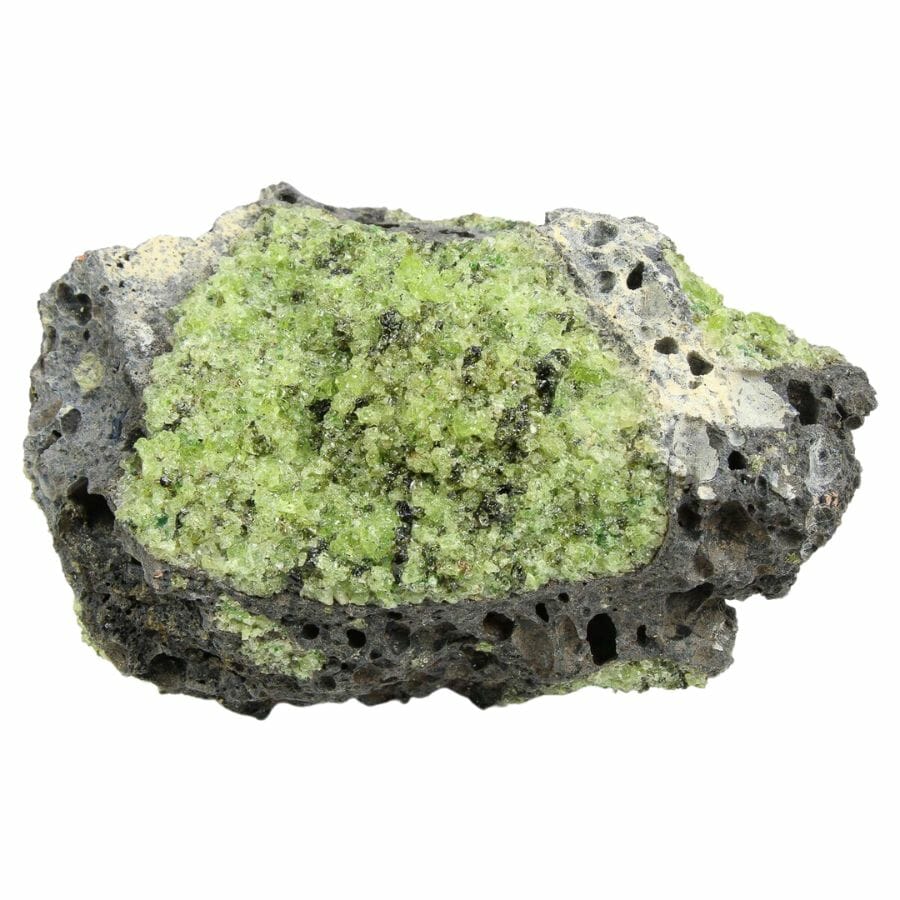
The way a mineral grows, or its crystal habit, tells a lot about its story. In the case of peridot, it often shows up as compact or granular masses. This means you’ll typically find it in formations that are dense and closely packed together.
It’s also not uncommon to find peridot as loose or embedded grains, like tiny green specks sprinkled in a rock or sand.
And for those exploring volcanic areas, there’s a neat surprise! Peridot can sometimes be found in volcanic nodules, which are rounded lumps formed by volcanic activity.
What peridot looks like on the inside
Peridot is more than just a pretty face; it has intriguing inner qualities too. When we dive deeper and examine its inner characteristics, we uncover a world of unique features.
Fracture
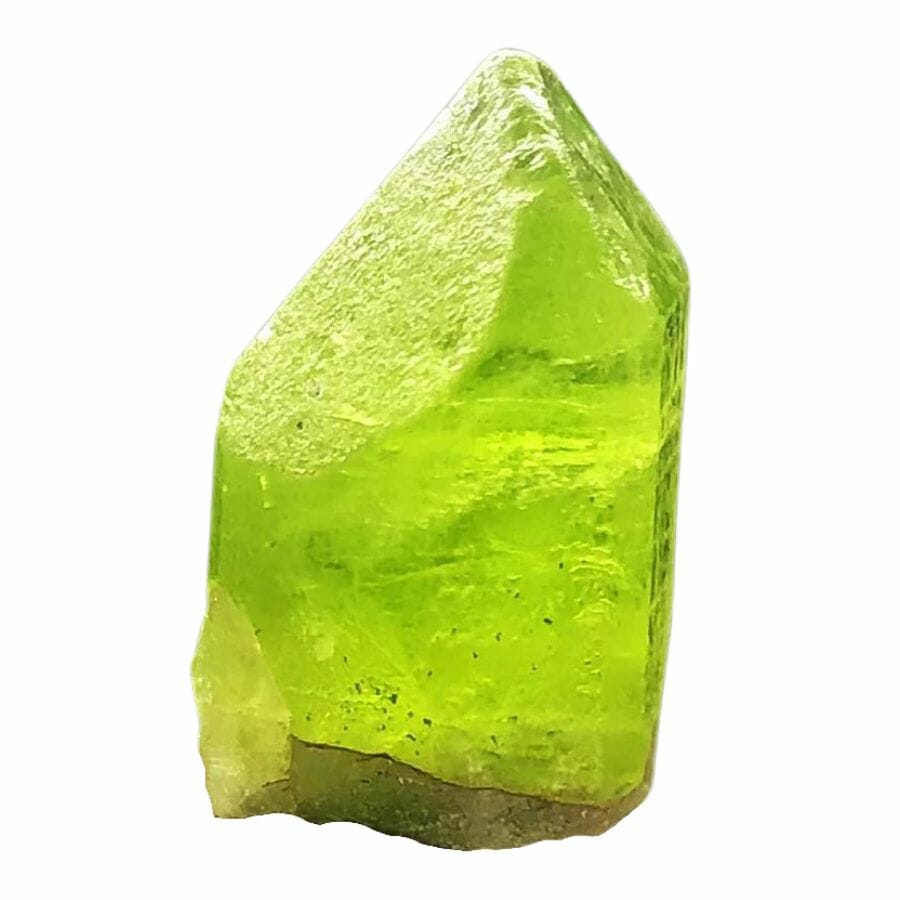
The way a gemstone breaks can offer valuable insights. In the case of peridot, if you come across a piece that’s been broken, take a closer look at its edges. You might notice a distinctive pattern, known as conchoidal fracture.
This type of breakage creates curves and ripples that resemble the inside of a seashell. It’s similar to the fracture patterns found in materials like quartz or glass.
Spotting this shell-like pattern on a broken edge can be a helpful clue in identifying the stone as peridot.
Inclusions
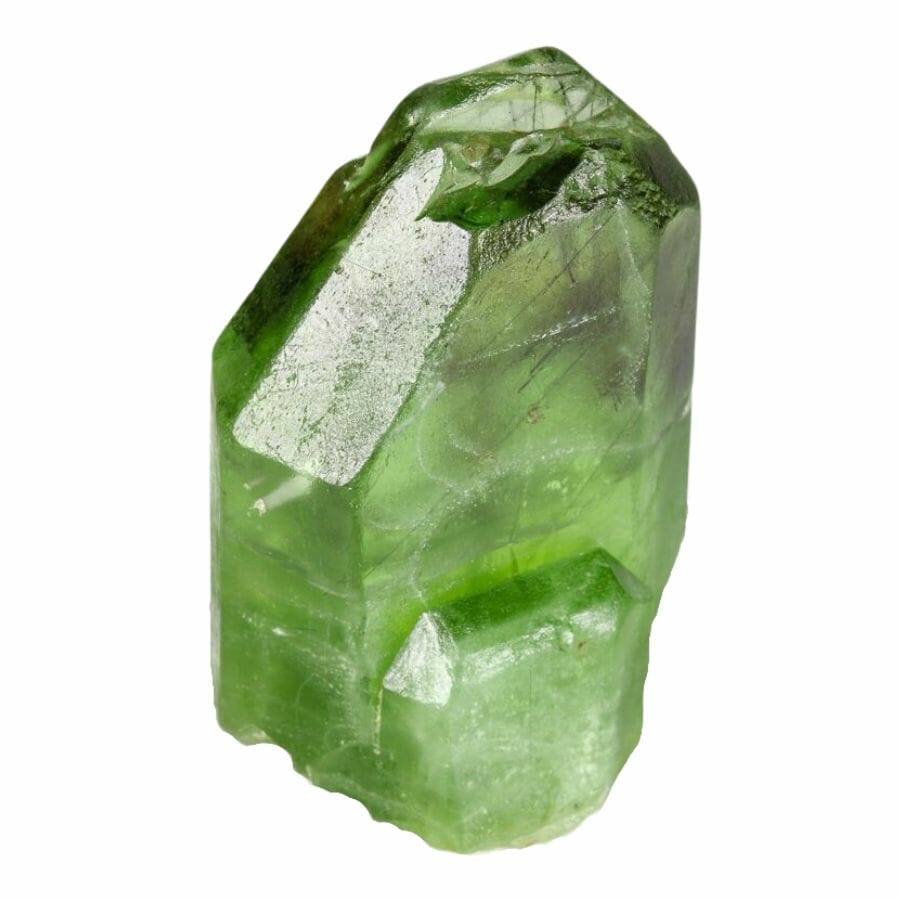
In the world of gemstones, inclusions are like tiny fingerprints, offering clues about a stone’s history and formation.
In raw peridot, it’s not uncommon to spot small black or dark bits trapped inside the stone. These tiny inclusions can give the gem a unique character and identity.
So, when you’re examining peridot, keep an eye out for these intriguing internal features; they’re a fascinating part of this gem’s tale!
Translucency
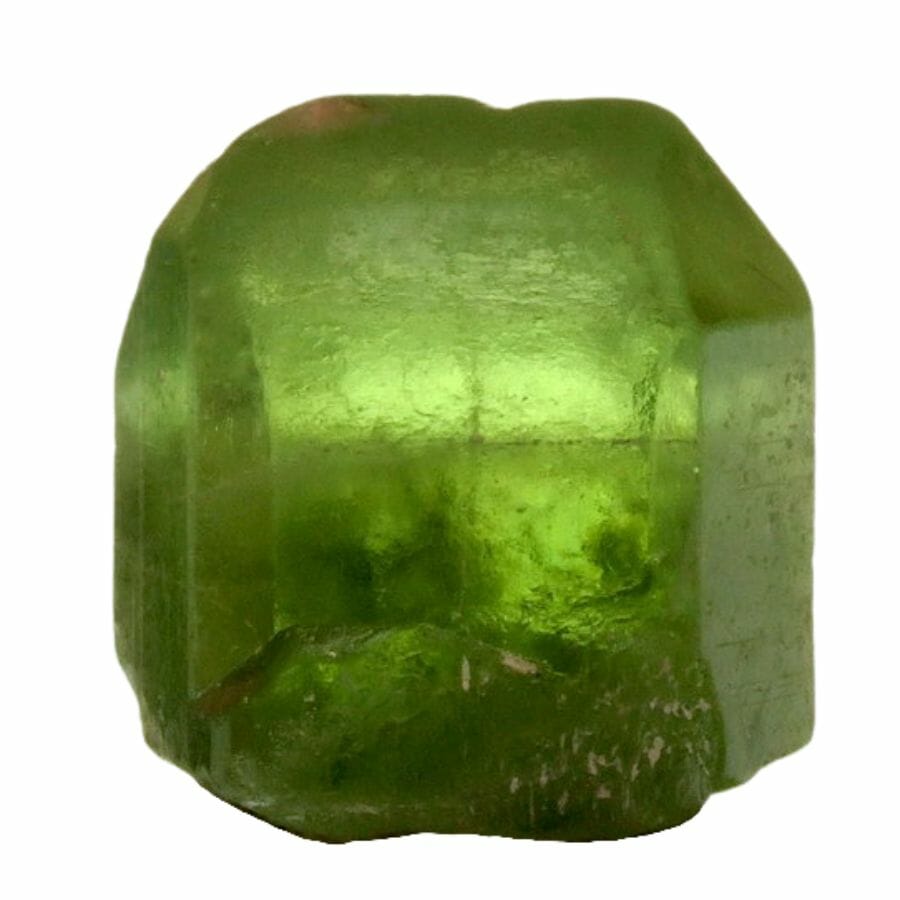
A peek into what peridot looks like on the inside reveals a captivating world of clarity. Raw peridot, with its lovely green hue, can range from translucent to transparent.
This means that when you hold a piece up to a light, it allows that light to pass through.
With thinner or smaller chunks of this gem, the effect can be particularly mesmerizing. It’s like holding a tiny piece of green-tinted glass, with light filtering through and showcasing the stone’s clarity.


